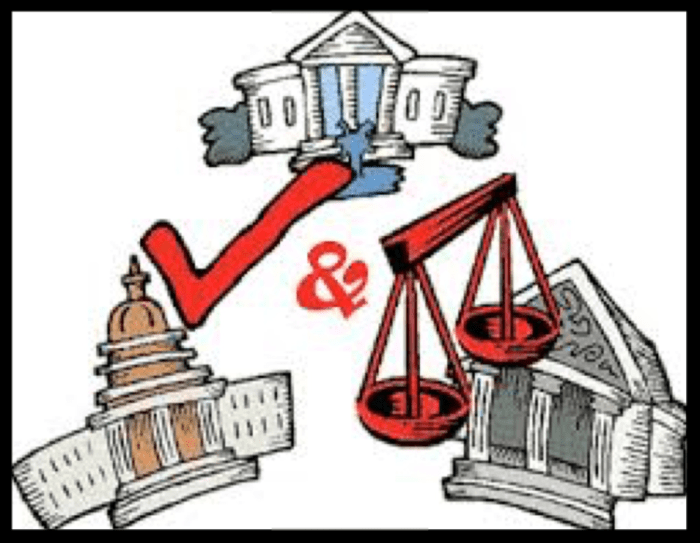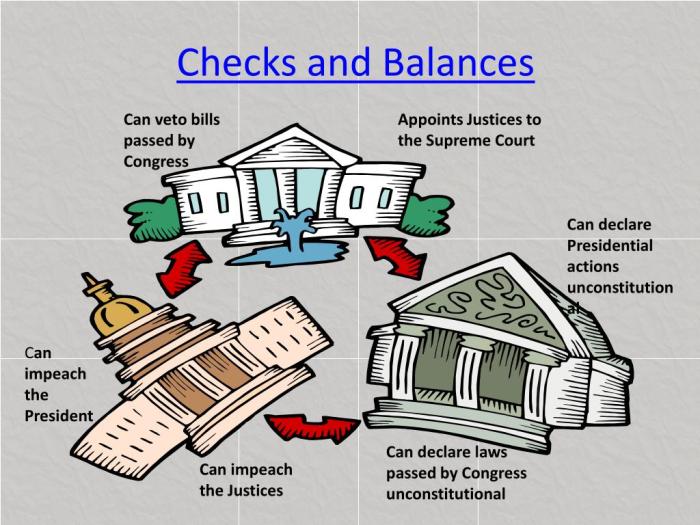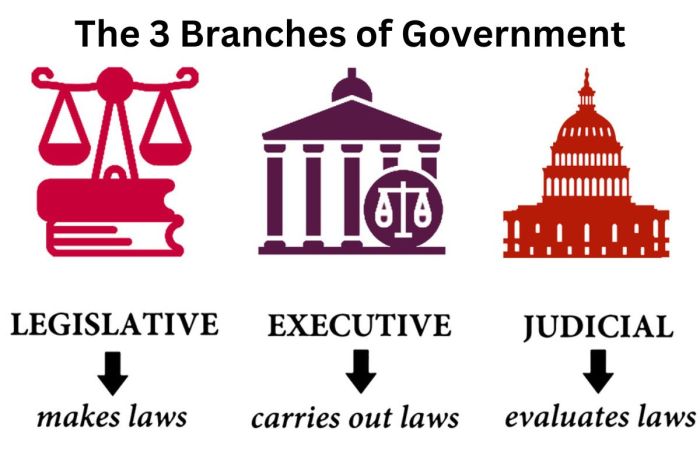- The Judicial Branch and the Power of Judicial Review
- The Role of the Supreme Court in Constitutional Interpretation
- The Impact of Judicial Review on the Separation of Powers
- The Relationship Between Judicial Review and Democracy
- Conclusive Thoughts
- Question & Answer Hub: Which Branch Can Declare Laws Unconstitutional
Which branch can declare laws unconstitutional? This fundamental question lies at the heart of the American system of government, shaping the very fabric of our nation’s legal landscape. The answer, enshrined in the Constitution, is the judicial branch, specifically the Supreme Court. This power, known as judicial review, grants the Court the authority to determine whether laws passed by Congress or state legislatures are consistent with the Constitution. This power is a cornerstone of American democracy, ensuring that the government remains accountable to the rule of law.
The concept of judicial review, while deeply ingrained in American law, is not without its complexities. The Supreme Court’s role in interpreting the Constitution has been a subject of ongoing debate, with differing opinions on the appropriate balance between judicial activism and restraint. Understanding the historical development, philosophical underpinnings, and potential implications of judicial review is crucial for grasping the dynamic interplay between the three branches of government.
The Judicial Branch and the Power of Judicial Review

The judicial branch of the United States government, with the Supreme Court at its apex, plays a crucial role in ensuring the balance of power and upholding the Constitution. This branch is responsible for interpreting the laws and determining their constitutionality, a power known as judicial review.
The Historical Context of the Judicial Branch
The establishment of the judicial branch can be traced back to the founding of the United States. The framers of the Constitution recognized the need for an independent body to interpret the laws and resolve disputes between the different branches of government. The Constitution, in Article III, established the Supreme Court and gave Congress the power to create lower federal courts. The early Supreme Court, under Chief Justice John Marshall, played a significant role in shaping the American legal system.
The Concept of Judicial Review
Judicial review is the power of the judiciary to review laws and actions of the legislative and executive branches of government and to declare them unconstitutional if they violate the Constitution. This principle, although not explicitly stated in the Constitution, was established in the landmark case of *Marbury v. Madison* (1803). In this case, Chief Justice Marshall asserted that the Supreme Court had the authority to strike down laws that were inconsistent with the Constitution.
Landmark Supreme Court Cases Involving Judicial Review
The Supreme Court has exercised its power of judicial review in numerous landmark cases throughout history, shaping the course of American law and society. Here are some notable examples:
- *Brown v. Board of Education* (1954): This case declared state laws establishing separate public schools for black and white students unconstitutional, marking a significant step towards racial equality in the United States.
- *Roe v. Wade* (1973): This case recognized a constitutional right to abortion, sparking ongoing debates about the balance between individual rights and societal values.
- *Obergefell v. Hodges* (2015): This case legalized same-sex marriage nationwide, recognizing the right to marriage equality as a fundamental human right.
The Role of the Supreme Court in Constitutional Interpretation
The Supreme Court of the United States plays a pivotal role in interpreting the Constitution and determining the constitutionality of laws. This power, known as judicial review, allows the Court to strike down laws or actions that violate the Constitution, ensuring that the government operates within its prescribed limits.
Methods of Constitutional Interpretation
The Supreme Court employs various methods to interpret the Constitution, each with its own strengths and weaknesses. These methods provide frameworks for understanding the meaning and application of the Constitution in contemporary society.
- Originalism: This approach emphasizes the original intent of the Founding Fathers, seeking to understand the Constitution based on its historical context and the framers’ understanding of its provisions. Originalists believe that the Constitution should be interpreted according to its original meaning, avoiding modern interpretations or evolving societal norms.
- Textualism: Textualists focus on the plain meaning of the words in the Constitution, arguing that the text itself provides the best guide to its interpretation. They believe that the Constitution’s language should be interpreted literally, without resorting to external sources or subjective interpretations.
- Living Constitutionalism: This approach views the Constitution as a dynamic document that should be interpreted in light of contemporary values and societal changes. Living constitutionalists believe that the Constitution should adapt to changing circumstances and reflect the evolving needs of society.
- Pragmatism: Pragmatists prioritize the practical consequences of judicial decisions, focusing on the real-world effects of constitutional interpretation. They believe that the Court should consider the practical implications of its rulings and strive to achieve the best outcome for society.
Judicial Activism versus Judicial Restraint
The concept of judicial activism versus judicial restraint refers to the degree to which the Court should exercise its power of judicial review.
- Judicial Activism: This approach advocates for a more active role for the Court in shaping public policy and interpreting the Constitution broadly. Activists believe that the Court should use its power to address social issues and protect individual rights, even if it means reinterpreting the Constitution or striking down laws that are not explicitly unconstitutional.
- Judicial Restraint: This approach emphasizes deference to the legislative and executive branches, arguing that the Court should only strike down laws that clearly violate the Constitution. Restraint proponents believe that the Court should avoid making policy decisions and instead focus on upholding the existing legal framework.
The Impact of Judicial Review on the Separation of Powers
The power of judicial review, the ability of the Supreme Court to declare laws unconstitutional, has a significant impact on the balance of power among the three branches of government. This power allows the judiciary to check the actions of the legislative and executive branches, ensuring that they act within the confines of the Constitution. However, it also raises concerns about the potential for judicial overreach and the potential for the judiciary to become too powerful.
Arguments for and Against Judicial Review
The debate over the merits of judicial review has been ongoing since its inception. Advocates argue that it is essential to safeguard individual liberties and prevent the tyranny of the majority. They contend that the judiciary, as an independent branch, is uniquely positioned to interpret the Constitution and protect its principles from encroachment by the other branches. Opponents, on the other hand, argue that judicial review gives the judiciary too much power and undermines the democratic process. They argue that the judiciary is not accountable to the people in the same way that the legislative and executive branches are, and that it is not equipped to make policy decisions.
- Arguments for Judicial Review:
- Protection of Individual Rights: Judicial review safeguards individual liberties by ensuring that laws do not violate the Constitution. For example, the Supreme Court’s decision in *Brown v. Board of Education* (1954) struck down segregation in public schools, ensuring equal access to education for all citizens. This landmark case demonstrates the judiciary’s role in protecting fundamental rights against the potential for majority rule to infringe upon them.
- Check on Legislative and Executive Power: Judicial review acts as a check on the legislative and executive branches, preventing them from exceeding their constitutional authority. This prevents the concentration of power in any one branch and helps maintain the balance of power established by the Constitution.
- Interpretation of the Constitution: The judiciary is uniquely positioned to interpret the Constitution, ensuring that its principles are upheld and applied consistently. This is crucial for ensuring the stability and predictability of the legal system.
- Arguments Against Judicial Review:
- Judicial Overreach: Critics argue that judicial review can lead to judicial overreach, where the judiciary goes beyond its role as interpreter of the Constitution and makes policy decisions that should be left to the elected branches. This can be seen as undemocratic, as unelected judges are making decisions that affect the lives of millions of people.
- Lack of Accountability: Unlike the legislative and executive branches, the judiciary is not directly accountable to the people. This can make it difficult to hold judges responsible for their decisions, and can raise concerns about the potential for judicial bias or abuse of power.
- Undermining the Democratic Process: Judicial review can undermine the democratic process by overriding the will of the people expressed through their elected representatives. For example, the Supreme Court’s decision in *Citizens United v. Federal Election Commission* (2010) allowed corporations and unions to spend unlimited amounts of money on political campaigns, raising concerns about the influence of wealthy interests in elections.
- Appointment Process: The President nominates Supreme Court justices, and the Senate confirms them. Both the President and Senators are elected officials, and their choices are often influenced by public opinion.
- Public Discourse: Public debate and media coverage of controversial issues can shape the Court’s understanding of societal values and expectations.
- Judicial Restraint: Judges may be more likely to defer to legislative decisions on matters where there is strong public support, demonstrating a form of judicial restraint.
- Majority Rule vs. Minority Rights: Judicial review can protect minority rights from being overridden by the majority. This can be seen as upholding democratic principles by ensuring equal protection under the law.
- Checks and Balances: Judicial review serves as a check on the power of the legislature and the executive branch, preventing abuses of power and promoting a balance of authority. This is a key aspect of a functioning democracy.
- Potential for Judicial Activism: Some argue that judicial review can lead to judicial activism, where judges go beyond interpreting the law and effectively make policy decisions. This can be seen as undemocratic, as it undermines the authority of elected officials.
- Landmark Decisions: Decisions like Brown v. Board of Education (1954) and Roe v. Wade (1973) have fundamentally changed American society, influencing legislation, social attitudes, and even cultural norms.
- Interpretation of Laws: The Court’s interpretations of laws can influence how those laws are implemented and enforced, shaping public policy in various areas.
- Setting Precedents: Supreme Court decisions set precedents that lower courts must follow, ensuring consistency and uniformity in the application of the law, which can impact policy and social norms.
The Relationship Between Judicial Review and Democracy

The power of judicial review, while essential for upholding the Constitution, raises important questions about its compatibility with democratic principles. This power allows unelected judges to invalidate laws passed by democratically elected legislatures, potentially creating a tension between the will of the people and the interpretations of the judiciary.
Public Opinion and Supreme Court Decisions
The Supreme Court is not entirely insulated from public opinion. Public sentiment can influence the Court’s decisions in several ways.
However, the Court is also designed to be independent of short-term political pressures. Justices serve life terms, and their decisions are based on their interpretation of the Constitution and the law, not on the whims of public opinion.
The Potential Impact of Judicial Review on Democratic Values, Which branch can declare laws unconstitutional
Judicial review can impact democratic values in several ways:
The Court’s Influence on Public Policy and Societal Norms
The Supreme Court’s decisions can have a significant impact on public policy and societal norms.
Conclusive Thoughts

The power to declare laws unconstitutional is a powerful one, entrusted to the judicial branch to ensure that the government remains true to the Constitution’s principles. While the Supreme Court’s role in this process has evolved over time, its impact on American society is undeniable. From landmark cases that have shaped our understanding of civil rights to decisions that have redefined the balance of power between the federal government and the states, the Supreme Court’s exercise of judicial review continues to shape the course of American history. Understanding this power, its origins, and its implications is essential for any informed citizen seeking to engage in the ongoing dialogue about the future of our democracy.
Question & Answer Hub: Which Branch Can Declare Laws Unconstitutional
What is the basis for judicial review?
The basis for judicial review is rooted in the Constitution, although it is not explicitly stated. The Supreme Court has interpreted the Constitution to grant it the power to review laws and determine their constitutionality.
What are some examples of landmark Supreme Court cases where the Court declared laws unconstitutional?
Some landmark examples include Marbury v. Madison (1803), which established the principle of judicial review; Brown v. Board of Education (1954), which declared racial segregation in public schools unconstitutional; and Roe v. Wade (1973), which recognized a constitutional right to abortion.
How does public opinion influence the Supreme Court’s decisions?
While the Supreme Court is designed to be independent of public opinion, it is not entirely immune to its influence. Public opinion can shape the Court’s perception of the issues before it and can influence the way the Court frames its decisions.
